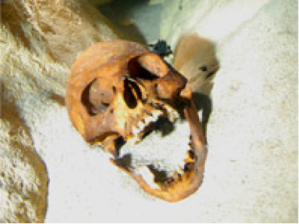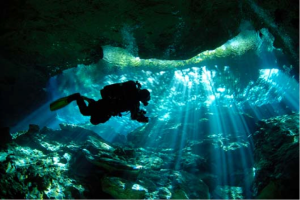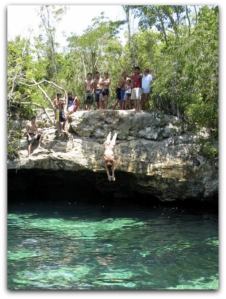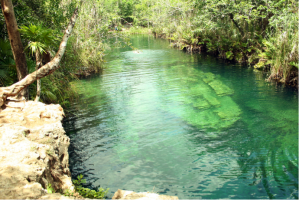Cenote
“The watery graves of the Maya”, an article featured in National Geographic brought me to this part of the world and ignited my curiosity of the ancient Mayan underworld.
Hundreds of cenotes exist in the Yucatan Peninsula, and believed to have been used by the pre-hispanic and contemporary Mayan people both as a source of fresh water and as a setting for sacred rituals, especially those dedicated to the rain gods.
A local guide told me that a team of archaeologists, cavers, photographers, and local guides entered the jungle in hopes of uncovering the way caves were used by the ancient Maya to enact rituals and communicate with spirits to elevate their social and religious status. Through their excavation efforts, researchers documented petroglyphs (rock engravings) and ancient pathways, as well as offerings such as human remains, ceramics, and jewellery dating from 800 B.C. to after contact with the Spanish.
I was starstruck by the cenotes and the stories behind it. But these are just theories, about which we can only speculate.
True or not it took less than one minute to completely win me over.
Ancient Maya relics and human remains are discovered deep within the sacrificial pit of a cenote in Cancun
Cenotes were considered sacred places of the Mayans not only because they were the only source of fresh water, but also because they represented the entrance to Xibalba, the underworld where their gods lived.
Some cenotes played important roles in Mayan rituals, believing that these pools were gateways to the afterlife and the home of their gods the Mayans sometimes threw valuable items into them.
It is also believed that cenotes were involved in rituals of human sacrifice, both valuable sacrificial objects and human skeletons having been discovered in several cenotes along the Mayan Riviera.
A cenote are freshwater limestone sinkholes scattered throughout Mexico. There are thousands of them, 3,000 scattered all over Mexico. And they all look different.
Yucatan is home to the biggest single underwater cave system in the world, thanks to the fact that the entire peninsula is essentially sitting on a large layer of soluble limestone. Amazing! These cave systems often make their way to the surface and thus the cenotes are revealed.
CENOTE AUZL. Best kept secret.
Cenote Azul. Outside of Chetumal. 4 hours drive south of Cancun to be exact.
A local told me about it and we took a walk down a rocky jungle path and before we even arrived, a sweet fresh aroma hit me. It was one of the most beautiful places i think i have ever seen although it was perhaps the magic of the moment.
At the end of the path we discovered a little paradise, a great place to swim and refresh, investigate the beautiful jungle fauna and even snorkel. Jump off the cliff if you are brave! I did. They say it is 92 meters deep around the edges and at least 150 meters deep in the middle.
The locals tell me there aren’t that many tourists here but on Sundays the local families fill the rocks around the swimming hole. I have to say this was a great way of sampling the sacred waters, like i was swimming in a little piece of history. I found it simply majestic.
CENOTE ESCONDIDO. Another best kept secret.
Cenote Escondido literally translates into “hidden cave”. Interesting story in its re-discovery as an American scuba diver entered the cave, gave up his old identity, moved to the Yucatan and become a Maya.
50 years down the track and there i was lucky enough to experience my 3rd cenote on my trip, each one with a different story attached to it.
Accompanied by my new bestie, a local called Juan, we walked about a kilometer through natural jungle filled with the most gigantic palm leaves i have ever seen. I even saw a spider monkey swinging around in the trees and except for 2 other locals, we were the only one’s there. Cenote Escondido was huge, deep and the water was crystal clear surrounded by rock cliffs about 4 meters high.
While visiting this hidden cenote though, i was in deep thought following a tale from local Maya elder about the mystical ‘alux‘ (similar to a leprechaun). Now in his late 60’s, the locals retold his story (through my translater Juan) of when he was 15 years old, relaxing below the two large palm leaves alongside the cenote after labouring all day long and heard the Chachalaka birds shouting out warning that someone was coming. He saw an 18 inch tall pot bellied naked man-like creature. The ‘alux’ however did not see him as by this stage the local was holding his breath under water in the cenote. The alux did eventually disappeared and his description of him was a hairless, dark-skinned creature with fingers the size of baby fingers.
Stories like these abound in the jungles of the Mayan Riviera and i was lucky enough to be shown the way to this hidden swimming hole.
Spanish records tell how live victims were thrown into the sacred cenote at Chichen Itza (a major Maya city), on the premise that, as sacrifices to the gods, they would not die—even though they were never seen again.
For most of us, a cenote is just a hole with water. But it is not uncommon around this part of Mexico for an older person that still lives to tell the tale or a team of archeologists to say that young female virgins were sacrificed where God would open up a road to bring in the gold that exists ‘down there’.
Apparently they were not all young girls. And that they were not all sacrificed.
The discovery of a 6 human including 2 children – jade beads, stone tools and other treasures found deep in Chichen Itza’s cenotes supports the idea that, for the Maya, cenotes represented a communication channel with the spiritual and sacred world. Others speculate remains and artifacts were ‘tossed’ into the cenotes themselves.
We’ll probably never know the real answer. And I think that may actually be better. These unanswerable questions only add to the mysticism of cenotes, and isn’t that ever so much more fun?!






